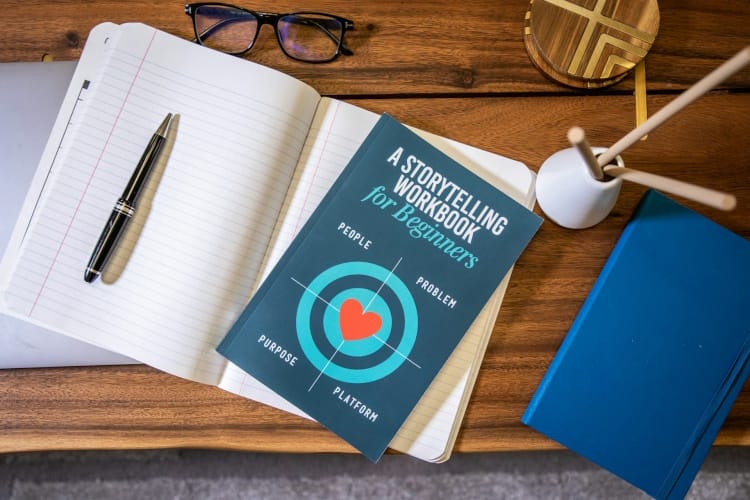In the digital era, it is crucial for you as an artist to effectively present your works online effectively. Visual storytelling is a suitable tool to establish a deeper connection to your audience and show your works of art in a new light.
This article explains what visual storytelling is, why it is so effective and how you can successfully implement it for an artist website without any technical knowledge.
What is visual storytelling / visual storytelling?
Visual storytelling means telling stories through visual elements such as images, videos, and graphics. It's about evoking emotions, conveying messages, and taking your visitors on a journey.
For you as an artist, this concept allows you to not only show the finished artwork, but also to portray the creative process, inspiration, and meaning behind the works.

photo of rain bennett @rainbennett, via unsplash
According to White Crab Systems, Visual storytelling is a powerful means of captivating users and building a deeper bond with the brand or an artist. By using visual stories, you can communicate complex ideas and emotions in a vivid way that often cannot achieve words alone.
Why is visual storytelling important for artists?

- Emotional connection : stories leave a lasting impression and touch people on an emotional level. By telling the story behind your works, you can establish a deeper connection to your audience.
- Emphasize uniqueness : In a world full of content, visual storytelling helps you to stand out from other artists and to present their unique perspective and style.
- Providing understanding and context : By telling stories, you can convey the context of your works and make your audience better understand your art.
- Promote commitment : Well told visual stories increase the interaction and commitment of your visitors. Ultimately, this can lead to more sales and a larger fan base.
Why does storytelling work? The mechanisms of action behind the method
The basic idea of the storytelling can be traced back to a fascinating aspect of human evolution: Over the years, our brains have developed a remarkable ability to tell, understand and, above all, preserve stories. This congenital tendency is deeply anchored in our DNA and forms the foundation for our interpersonal communication.
It is in a clear contrast to dry, analytical approaches, as often prevailed in the online world, where often on sober facts, stiff visualizations and rational argument.
The power of storytelling is impressively demonstrated by the results of experiments conducted at the renowned Stanford University . These studies revealed that people can remember stories up to 22 times more effectively than abstract information presented as a mere list of facts.
This is a revolutionary insight that not only influences how we communicate, but also how we process and retain information. The emotional content of a story —its characters, conflicts, and turning points—tap into our empathic abilities, thus fostering a deeper connection between the storyteller and the audience.
If we remember that stories have always been an essential component of human culture - only think of the traditions around the campfire or the old myths - we recognize the immense potential that contains storytelling in all areas of life.
Through skillful storytelling, artists can not only present their brand more powerfully but also build long-term relationships with customers, buyers, collectors, and patrons. The ability to package information in the form of stories opens up new avenues of learning and understanding and not only sticks in the memory, but also directly inspires engagement with the content conveyed on a deeper level.
Visual storytelling now uses other media instead of text or spoken words: images, graphics, layouts, photographs, colors, patterns and pictorial visualizations.
It is up to us to use this tried and tested method of storytelling to make information and offers alive and memorable.
The elements of visual storytelling
For effective visual storytelling, you should take various elements and techniques into account:
- Clear story : Every good story has a beginning, middle and an end. Think about which story you want to tell and how you can lead your audience through them.
- Consistent aesthetics : A uniform visual style helps to make your brand appear recognizable and professional. Choose colors, fonts and layouts that fit your art style and add them.
- Emotional pictures : Choose pictures and graphics that cause strong emotions and support the core message of your history.
- Interactive elements : With the integration of interactive elements such as slideshows, videos or animations, you can actively involve your audience and make the experience more intensely.
- Authenticity : Be honest and authentic in your presentation. Show not only the shiny surface, but also the process, the challenges and the personal aspects of your art.
Practical implementation with a homepage kit
But how can you practically implement the elements of the storytelling? Perhaps you don't have sufficient time resources or a lack of technical knowledge to create a professional website yourself?
website builders are an excellent choice: They give you all the tools you need to implement effective visual storytelling on your website, even if you have no programming skills.

We now go into step by step how you can implement homepage kit from One.com
01 tell a story
You can present your story structured with flexible layout options:
- Landing page as an introduction : Design an inviting start page that your audience immediately delves into your world. Use large background images or videos that give a first impression of your art and style.
- About Mich page : Tell your personal story, your career and what inspires you. Use photos of yourself in your studio or working on your works to establish a personal connection.
- Portfolio pages : Order your works thematically or chronologically and add descriptions that explain the history and meaning of each piece.
02 Create a consistent aesthetics
You have a variety of design templates and adjustment options to choose from:
- Color scheme : Choose a color scheme that supplements your works of art and conveys the desired mood. You can create your own color pallets or choose from predefined options.
- Font : Decide on fonts that fit your style and ensure readability. Combine different fonts for headings and body text to create visual interest.
- Layout : Use various layouts to present your content clearly and appealing. With the drag-and-drop editor you can easily place and adapt elements.
03 Use emotional pictures
The homepage kit makes it very easy for you to add and present pictures:

- Galleries and slideshows : Create impressive picture galleries that present your works in high quality. With slideshows you can tell stories by arranging pictures in a certain order.
- Fullscreen backgrounds : Use large-format images or videos as backgrounds to immediately attract the attention of your website visitors and create a pleasant atmosphere.
- Capitations and descriptions : Add informative and emotional descriptions that explain the context and history behind every work.
04 Integrate interactive elements
Interaction promotes commitment and makes the experience more exciting for your visitors:
- Include videos : Show videos of your creative process, interviews or presentations of your works. You can simply integrate videos from platforms such as YouTube or Vimeo or upload your own files.
- Animations and effects : Use subtle animations and hover effects to bring dynamics to your website and to emphasize certain elements.
- Contact and feedback forms : Encourage your audience to get in touch with you or give feedback by inserting user-friendly forms.
05 Show authenticity through content
Present your audience the real stories behind your art:
- Blog : Share updates, stories and thoughts in an integrated blog regularly. Talk about current projects, inspiration or events in which you participate.
- Testimonials and customer reviews : Present feedback from satisfied customers or critics to build trust and to underline the quality of your work.
- Social media integration : Connect your website to your social media channels to share current content and strengthen your online presence. You can display the feeds of platforms such as Instagram or Facebook directly on your page.
Practical tips for effective visual storytelling

Photo by
Kelly Sikkema @kellysikkema, via unsplash
- Planning is crucial : Before you start the design of your website, plan the story you want to tell and how you can visually represent you.
- Less is more : Do not overload your site with too many elements. A clear and focused design helps your audience to concentrate on the essentials.
- Mobile Optimization : Make sure that your website looks good and works on all devices. So -called responsive designs automatically adapt to different screen sizes.
- Continuous update : Keep your content fresh and up to date by regularly adding new stories, works and updates.
3 Website examples that use storytelling in an amazing way
And a few more inspiration for a successful implementation of TemplateMonster:
Conclusion
Visual storytelling is a mighty tool that enables you as an artist to present your works online in a profound and appealing way. By telling stories, you can build a stronger bond with your audience, highlight your unique artistic profile and ultimately increase the success of your online appearance.
With a homepage kit you have all the necessary tools at hand to implement your history (s) effectively and professionally. The user -friendly platform - for example from One.com - allows you to create an impressive and functional website that puts your works of art in the best light and tells your personal story.
Use the possibilities of visual storytelling and let your creativity not only shine in your works, but also in your web design. Tell stories that inspire, move and connect - and open new doors for your artistic career in the digital world.
Here you will find useful tips on creating websites using a homepage builder or website builder tool .

Owner and Managing Director of Kunstplaza. Publicist, editor, and passionate blogger in the field of art, design, and creativity since 2011. Successful completion of a degree in web design as part of a university program (2008). Further development of creativity techniques through courses in free drawing, expressive painting, and theater/acting. Profound knowledge of the art market through many years of journalistic research and numerous collaborations with actors/institutions from art and culture.

















